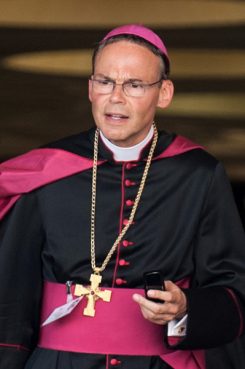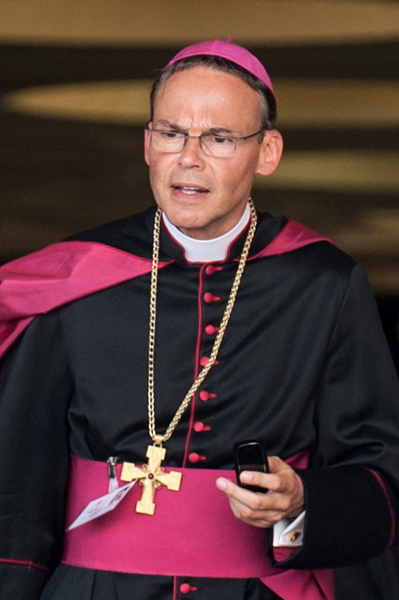
Bishop Franz-Peter Tebartz-van Elst of Limburg, Germany, leaves a meeting of the Synod of Bishops on the new evangelization at the Vatican in this Oct. 19, 2012. Photo by Alessia Giuliani, courtesy CNS
BERLIN (RNS) The $20,000 bathtub and $482,000 walk-in closets ordered by “Bishop Bling-Bling” — the moniker of Franz-Peter Tebartz-van Elst, the now-suspended bishop of Limburg — have scandalized the German public.
But Tebartz-van Elst, 52, is only the latest German clergyman to run into trouble since Pope Francis took the helm of the Roman Catholic Church. Francis temporarily suspended the bishop on Wednesday while a church commission investigates the expenditures on the $42 million residence complex.
As the new pontiff tries to reform the way the church does business, German dioceses, which reportedly include the world’s wealthiest in Cologne, are chafing under the new direction as membership numbers continue to dwindle.
“Tebartz-van Elst is just the tip of the iceberg,” said Christian Weisner, spokesman for the German branch of We Are Church, an organization advocating Catholic Church reform. “There is a real clash of cultures between Germany’s current cardinals and bishops — nominated under John Paul II or Benedict XVI — and Pope Francis.”
Since becoming pope, Francis has repeatedly urged the church to strip itself of all “vanity, arrogance and pride” and humbly serve the poorest in society. Under Francis, priests living in luxury are no longer merely unseemly, but a scandal.
Still, even as Francis drives around Vatican City in a 20-year-old white Renault clunker gifted by an Italian priest, the head of the German Bishops’ Conference, Archbishop Robert Zollitsch, balked at the idea of giving up his company car, a BMW 740d.
“To me that car is not a status symbol, it is the office I use when I am traveling,” Zollitsch said at a press event in early October, when asked whether he would trade it down.
In Germany, most of the church’s top officials drive high-powered Mercedes, BMWs or Audis.
Other German clergymen have been chastised for lavish expenditures. Cardinal Reinhard Marx of Munich’s archdiocese spent around $11 million renovating the archbishop’s residence and another $13 million for a guesthouse in Rome.
Still, for German Catholics, those luxuries pale in comparison to the current case surrounding Tebartz-van Elst and the renovation of his residence in Limburg, which is close to Frankfurt. Originally, the refurbishment of the estate’s 10 buildings had been slated to cost $7.5 million but it ballooned to almost six times that amount because of extravagances such as expensive fixtures.
Carsten Frerk, who specializes on church finances in Germany, said German bishops’ reluctance to follow Francis’ new course is no surprise.
“The German Catholic Church is one of the country’s wealthiest and largest organizations and its top officials expect a certain lifestyle,” said Frerk, who has published two books on the German churches’ wealth and what he describes as their opaque financing. “But they are wary of the extent of their wealth becoming broadly known because it might lead to fewer donations.”
There are 23 million German Catholics who have declared their faith and by law must pay 8 to 10 percent of their incomes to their respective churches. That brought the Catholic Church $7.1 billion in tax revenue in 2012.
Since the secularization process instigated by Napoleon in the early 19th century, the state also pays the Protestant and Catholic churches an annual allowance as compensation, which yielded a combined total of about $12 million for the Christian groups in 2012.

Head of the German Bishop’s Conference, Robert Zollitsch. Photo courtesy Andreas Gerhard/Bishopric of Freiburg.
But the 27 Catholic dioceses in Germany have a large number of assets, such as real estate or bonds. According to John Berwick, religious affairs analyst for German broadcaster Deutsche Welle, the diocese of Cologne is richer than the Vatican.
Meanwhile, the case of Tebartz-van Elst has focused the spotlight on the church’s opaque financing.
In 2010, 25 of Germany’s 27 dioceses refused to supply the newsweekly Der Spiegel with information on their budgets and assets. Following the Tebartz-van Elst scandal, several bishoprics — including Cologne, Hamburg, Essen and Munster — have made their financial figures public.
There are advantages to the German church’s wealth. Mathew Schmalz, theologian and professor at the Massachusetts-based College of the Holy Cross, who now lives in Sri Lanka, said that without its resources, the church could not support projects in developing countries.
And in Germany, that is the crux of the problem, say analysts. It is important to show congregations that clergy are not the arrogant, aloof spiritual advisers that many German Catholics believe they have become.
For example, after the spending on the renovations came to light, petitions for Tebartz-van Elst to step down circulated. But the bishop remained silent.
And even though he flew to Rome for an audience with the pope on a budget flight rather than the first-class fare, many say such a gesture was too little too late.
Now the question remains to what extent the traditional German church can keep step with Pope Francis’ reforms and whether their efforts could put a stop to their bleeding membership rolls — predicted to reduce Christians to a minority within Germany in the next 20 years.
In 2010, 181,000 left the church after the sexual abuse scandals involving German priests were made public. Another 126,000 in 2011 and 118,000 in 2012 followed suit.
“I think this conflict surrounding Tebartz-van Elst, who is not willing to resign, will be one of the defining moments for the future course of the Catholic Church,” Weisner said. “This is a historic moment in time and a unique chance for renewal.”
(Sumi Somaskanda contributed to this story from Berlin.)
YS/AMB END BHATTI






